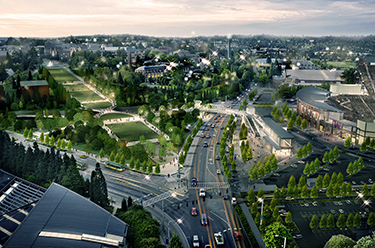|
Subscribe / Renew |
|
|
Contact Us |
|
| ► Subscribe to our Free Weekly Newsletter | |
| home | Welcome, sign in or click here to subscribe. | login |
Construction
| |
 |
November 21, 2013
Rainier Vista bridge fulfills a long-held vision for UW campus
KPFF and Gustafson Guthrie Nichol

Chase
|

McCann
|

Alonzo
|
The Rainier Vista axis is a central component of the University of Washington’s historic campus layout.
The vista was first conceived by the Olmsted Brothers as the central axis for the Alaska Yukon Pacific Exposition in the early 1900s. Framing a grand view of Mount Rainier, the vista remains a signature feature for the university. By linking the heart of the historic, collegiate Gothic campus with Drumheller Fountain, a “fountain to mountain” experience was created.
Yet for such a memorable view, the connecting paths and promenades that would allow for a full feeling of grandeur were never conceptualized. A new project titled the Montlake Triangle will connect the Rainier Vista to our region in a way that is worthy of the passing of time.
The Montlake Triangle takes its name from the triangular shape of its location at the intersection of Montlake Boulevard Northeast and Northeast Pacific Street between the UW Medical Center and Husky Stadium.
The design for the lower Rainier Vista integrates the isolated ground of the Montlake Triangle with two moves. One is lowering Northeast Pacific Place between the campus and the Montlake Triangle, effectively creating a single land mass through which Northeast Pacific Place is carved. The second move is the extension of the monumental axis onto the Montlake Triangle with a land bridge.
By claiming the Montlake Triangle as part of the Rainier Vista axis, the university returns to previous visions that intended for the triangle to act as both a terminus of the axis and a threshold into the university. The purity of the intent to frame the monumental view is restored and the identity of the central campus is solidified.
Activating the triangle
Physically severed from the rest of the vista, this 160,000-square-foot triangular parcel of land has primarily been used for parking (first as a surface lot and currently as a below-grade garage that serves the medical center). Further isolating the space is Pacific Place, which serves as a bypass between Montlake Boulevard and Pacific Street, and serves as the end of the line for several of Metro’s busiest east-west bus routes.
A series of improvements to the area have been designed by KPFF structural and civil engineers and Gustafson Guthrie Nichol landscape architects, with direction from the UW and project partners Sound Transit and the Washington State Department of Transportation.
Key objectives include: reconnecting the triangle to the modernized vista with a land bridge by lowering and improving Pacific Place; rebuilding a section of the Burke-Gilman Trail that passes through the site; providing a bridge connection for users of the new University Link light rail and for cyclists who are connecting to the Lake Washington Bicycle Loop Trail from the Burke-Gilman Trail; and activating the area with mixing plazas, lighting, upgraded bus stops, and accessible pathways to and from the campus.
| UW Montlake Triangle team |
|
University of Washington Project partners: Washington State Department of Transportation, Sound Transit, Seattle Department of Transportation General contractor: Sellen/Merlino JV Structural/civil engineer, prime administrator: KPFF Landscape architect/ project design lead: Gustafson Guthrie Nichol Geotechnical engineer: Shannon & Wilson Electrical engineer/ lighting designer: AEI/Pivotal Trolley systems engineer: LTK Engineering Services |
The land bridge
Gustafson Guthrie Nichol designed and developed the Rainier Vista land bridge as a formal extension of the historic axis while reconciling the technical challenges of the complicated site. Complexities include a site laced with regional sewer lines and essential university campus utilities; doing construction over an existing, below-grade garage; protecting heritage trees; and maintaining an active hub for Metro’s electric trolleys.
The bridge design responds to the physical constraints by narrowing at the waist above Pacific Place. This reduced costs, lessened the approach slopes on the road and Burke-Gilman Trail below, and minimized the bridge structure to improve daylighting and limit the overall scale of the bridge. The bridge design was refined by combining the idea of flexible pedestrian movement of the Liberal Arts Quadrangle with the form of the Gothic arches of Suzzallo Library.
KPFF developed innovative ways to control costs and simplify construction. The land bridge uses simple post-tensioned concrete beams while maintaining the appearance of the complex, curvilinear form of the bridge.
Below the walkway, Pacific Place will be lowered 19 feet at its lowest point, a depth necessary to accommodate Metro buses and their associated overhead electric trolley wire system. Construction in this area will be a challenge, as the workspace is hemmed in by the existing Burke-Gilman Trail on one side, an existing below-grade garage on the other, and a 12-foot-diameter brick sewer main nearby. An existing walk-through utility tunnel located beneath the lowered roadway will be so close to the lowest part of the rebuilt Pacific Place that KPFF designed an underground bridge structure over the top of it to protect the tunnel from the loads of vehicular traffic above.
The lowered Pacific Place roadway will also incorporate a rebuilt portion of the Burke-Gilman Trail. To maintain accessibility, the new trail portion doesn’t dip down as far as the new road, but rather splits the difference between the lowest portion of the road and the at-grade area above. Gabions — rock-filled, stacked wire baskets — provide a functional and aesthetic rise from the base of the new roadway back up to grade level.
KPFF evaluated the existing lid over the garage, since the new landform will add considerable depth above the structure. A collaborative effort among KPFF, GGN and Sellen/Merlino JV was required to find the right balance between soil and geofoam to satisfy the garage lid weight limitations. Pathways were created across the lid for use by equipment during construction as well as maintenance vehicles once the job is complete.
The triangle is the landing point for a new pedestrian bridge that will curve from the new Sound Transit University Link light rail station across Montlake Boulevard.
Trees and plants will help define the Rainier Vista extension and the Montlake Triangle as the most welcoming entrance to the university. GGN carefully studied how the landscaping will evolve. For example, the triangle’s strong southern exposure calls for plants that will hold up to direct sunlight but also flourish in the future as the canopy of new trees develops.
The Montlake Triangle project includes considerable updates to the axis that starts at Northeast Stevens Way. The gravel paths and the unused ramp to the garage will be filled and regraded. The grades gradually rise to 7 feet above existing grade as the axis reaches the triangle to accommodate Metro trolley clearance requirements at Pacific Place.
This rise is both technically necessary and visually deliberate, as it will offer a unique view of Mount Rainier that — from the north end of the vista — screens the view of traffic on Pacific Street and Montlake Boulevard. The result: a green axis that visually joins the formerly fractured vista with the Montlake Triangle.
Construction on the Montlake Triangle project begins in January. The university’s new “front door” is scheduled to open in March 2015.
Marty Chase is a civil engineer and principal at KPFF.
Jacob McCann is an associate at KPFF specializing in structural engineering.
Bernie Alonzo is a principal at Gustafson Guthrie Nichol with expertise in managing all aspects of sustainable landscape design.
Other Stories:
- UW builds new dorms to entice students to live on campus
- Wine center will support a growing state industry
- UW: Top 10 capital projects
- A home away from home for Native American students
- WSU: Top 10 capital projects
- A visitor center for the Facebook generation
- Apartment rehab will give students more ways to get social
- Design build cuts costs for WSU research lab
- Library overhaul was fast, cheap and efficient



